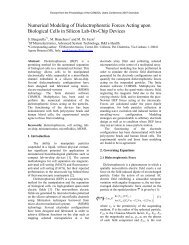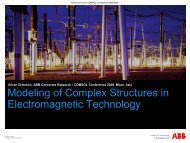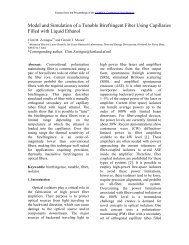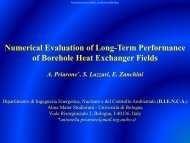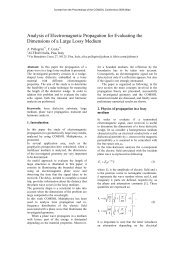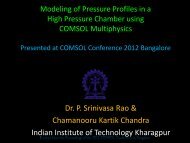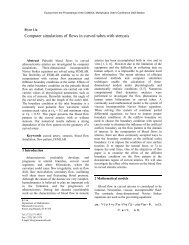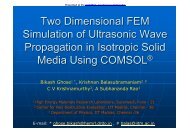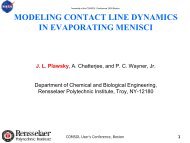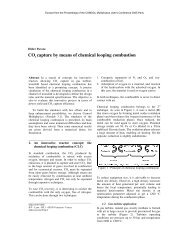[PDF] Modelling of seismoelectric effects - COMSOL.com
[PDF] Modelling of seismoelectric effects - COMSOL.com
[PDF] Modelling of seismoelectric effects - COMSOL.com
Create successful ePaper yourself
Turn your PDF publications into a flip-book with our unique Google optimized e-Paper software.
where c is the maximum wave speed, h is the<br />
grid spacing, and ∆t is the time step size. As<br />
seismic source we used a Ricker wavelet with a<br />
380 Hz centre frequency. The frequency was<br />
chosen on the basis <strong>of</strong> the finite-element size and<br />
resolving power <strong>of</strong> the spatial discretization.<br />
Since our model allows examination <strong>of</strong> the<br />
entire domain at a fixed point in time, or <strong>of</strong> a<br />
single point throughout the duration <strong>of</strong> the<br />
simulation, a full analysis <strong>of</strong> the different wave<br />
modes is possible. The coseismic wave and the<br />
interface responses are the most prominent and<br />
we will investigate where these waves originate<br />
and how they propagate. It is important to avoid<br />
spurious reflections in the model which would<br />
negatively affect the accuracy <strong>of</strong> the numerical<br />
solution. Therefore non-reflecting boundary<br />
conditions are applied, which damp the wave<br />
motion near the boundaries. Non-reflecting<br />
boundary conditions allow an outgoing wave to<br />
leave the modelling domain with no or minimal<br />
reflections. For the case <strong>of</strong> transient analysis,<br />
Givoli`s and Neta`s reformulation <strong>of</strong> the Higdon<br />
conditions (Givoli and Neta, 2004) for plane<br />
waves was implemented.<br />
Figure 1: 2D model setup featuring a clay lens at 4 m<br />
depth in a sand background, a subsurface seismic shot<br />
point, and an electrode receiver line at the ground<br />
surface.<br />
To simulate the <strong>seismoelectric</strong> <strong>effects</strong> in a<br />
porous medium, we used a simple model<br />
illustrated in Figure 1 that involves a clay lens in<br />
a sand background. The material properties for<br />
this setup are shown in the figure. We are<br />
particularly interested in the ability <strong>of</strong> the<br />
<strong>seismoelectric</strong> method to detect thin subsurface<br />
layers. The source/receiver configuration is also<br />
depicted in Figure 1. The explosion source is<br />
positioned nearly in the middle <strong>of</strong> the model 1 m<br />
above the clay lens. The receivers are arranged<br />
symmetrically at both sides <strong>of</strong> the source at the<br />
ground surface. The receiver spacing is 0.03 m.<br />
The example has the following medium<br />
parameters. The porosity ϕ is 30% in the sand.<br />
All layers are saturated with pore water <strong>of</strong> pH 7,<br />
salinity 0.001 mol/L, and a viscosity η <strong>of</strong> 10 -3<br />
Pa s. The Zeta potential is calculated using the<br />
relations provided by Pride and Morgan (1991)<br />
and therefore the corresponding electrokinetic<br />
coupling coefficient is set to L = 4.9e-7 m 2 /Vs.<br />
The permeability k is 0.1 D in the sand<br />
background and 0.1 mD in the clay lens. The<br />
electrical conductivity σ is 0.01 S/m in the sand<br />
background and 0.05 S/m in the clay lens.<br />
3. Results<br />
3.1 The <strong>seismoelectric</strong> <strong>effects</strong><br />
It has been theoretically shown that when a<br />
seismic wave propagates through a fluidsaturated<br />
porous medium, <strong>seismoelectric</strong><br />
coupling phenomena generate EM disturbances<br />
<strong>of</strong> three different types (Haines 2004). The first<br />
type is called direct field, because it can be<br />
thought <strong>of</strong> as analogous to the seismic direct<br />
wave. It is generated by charge separation at the<br />
impact point caused by the fluid pressure<br />
distribution and it occurs at the time <strong>of</strong> the<br />
source impulse and continues until the region <strong>of</strong><br />
the impact point has relaxed to its original state<br />
(Figure 2a). The second effect occurs when a<br />
seismic wave travels through a porous material,<br />
creating a fluid pressure gradient and an<br />
acceleration <strong>of</strong> the grain matrix. The associated<br />
charge separation manifests an electric field,<br />
collocated with the seismic wave; it is called<br />
coseismic field (Figure 2b). The third effect<br />
occurs when a mechanical disturbance<br />
encounters an interface in material properties.<br />
When crossing an interface between two layers<br />
with different properties, a seismic wave<br />
generates a time-varying charge separation<br />
which acts as a dipole radiating electromagnetic<br />
energy independently <strong>of</strong> the seismic wave. Due<br />
to constructive interference, a significant portion<br />
<strong>of</strong> the first Fresnel zone acts as a disk <strong>of</strong> electric<br />
dipoles oriented normal to the interface. This<br />
disk <strong>of</strong> dipoles oscillates with the waveform <strong>of</strong><br />
the seismic wave (Figure 2c).


![[PDF] Modelling of seismoelectric effects - COMSOL.com](https://img.yumpu.com/35231397/4/500x640/pdf-modelling-of-seismoelectric-effects-comsolcom.jpg)
![[PDF] Microsoft Word - paper.docx - COMSOL.com](https://img.yumpu.com/50367802/1/184x260/pdf-microsoft-word-paperdocx-comsolcom.jpg?quality=85)
